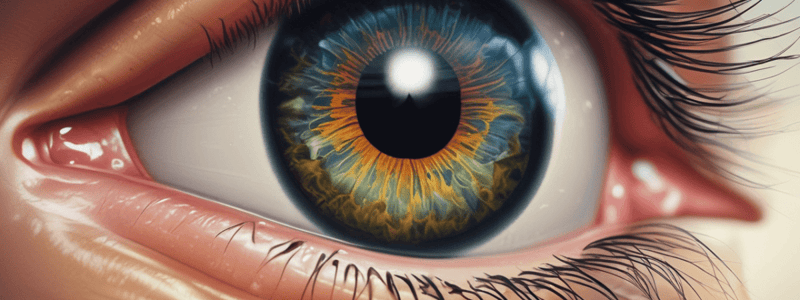Podcast
Questions and Answers
What is the difference in STT values between kittens and adult cats?
What is the difference in STT values between kittens and adult cats?
- STT values are not applicable to kittens and adult cats
- Kittens have lower STT values
- Kittens have higher STT values (correct)
- STT values are the same for kittens and adult cats
What is the effect of age on STT in adult cats?
What is the effect of age on STT in adult cats?
- Age is a significant factor in determining STT
- Age is not applicable to STT in adult cats
- Age is not a significant factor in determining STT (correct)
- Age is the only factor in determining STT
What is the reported range of mean TBUT for normal healthy dogs?
What is the reported range of mean TBUT for normal healthy dogs?
- 10.0– 15.0 seconds
- 20.0– 30.0 seconds
- 5.9– 8.6 seconds
- 14.7– 28.9 seconds (correct)
Why did the authors of the study use diluted fluorescein sodium?
Why did the authors of the study use diluted fluorescein sodium?
What did the study find about the TBUT values of brachycephalic breeds compared to non-brachycephalic breeds?
What did the study find about the TBUT values of brachycephalic breeds compared to non-brachycephalic breeds?
What is the range of mean TBUT values reported in the literature for normal healthy dogs?
What is the range of mean TBUT values reported in the literature for normal healthy dogs?
Flashcards are hidden until you start studying
Study Notes
Tear Film Instability in Dogs
- Unstable tear film (TF) was found in brachycephalic dogs compared to non-brachycephalic dogs.
- The TBUT (tear break-up time) of brachycephalic breeds was 18% more accelerated than non-brachycephalic breeds.
Normal TBUT Values
- Mean normal TBUT for adult healthy dogs: 14.7–28.9 seconds.
- Mean TBUT of both brachycephalic and non-brachycephalic breeds in the present study was at least 50% more accelerated than normal reference values.
Factors Affecting TBUT
- Environment: hot and dry weather may affect TBUT in dogs.
- Fluorescein volume and/or concentration may affect TBUT.
- Poor reliability of TBUT may be a factor.
- Season and environmental factors (temperature, humidity, and altitude) may affect TBUT in dogs.
Comparative Studies
- A recent study reported no difference in mean TBUT between different methods of fluorescein sodium application.
- Mean TBUT values for normal dogs: 5.9–8.6 seconds, similar to the present study.
TBUT-Affecting Factors in Other Animals
- Topical anesthetics, such as tetracaine, decrease TBUT in horses.
- In cats, TBUT is shorter with feline herpesvirus 1 (FHV-1) infection, ulcerative keratitis, conjunctivitis, and corneal sequestrum.
- Anesthesia reduces TBUT in cats.
Tear Film Instability in Dogs
- Unstable tear film (TF) was found in brachycephalic dogs compared to non-brachycephalic dogs.
- The TBUT (tear break-up time) of brachycephalic breeds was 18% more accelerated than non-brachycephalic breeds.
Normal TBUT Values
- Mean normal TBUT for adult healthy dogs: 14.7–28.9 seconds.
- Mean TBUT of both brachycephalic and non-brachycephalic breeds in the present study was at least 50% more accelerated than normal reference values.
Factors Affecting TBUT
- Environment: hot and dry weather may affect TBUT in dogs.
- Fluorescein volume and/or concentration may affect TBUT.
- Poor reliability of TBUT may be a factor.
- Season and environmental factors (temperature, humidity, and altitude) may affect TBUT in dogs.
Comparative Studies
- A recent study reported no difference in mean TBUT between different methods of fluorescein sodium application.
- Mean TBUT values for normal dogs: 5.9–8.6 seconds, similar to the present study.
TBUT-Affecting Factors in Other Animals
- Topical anesthetics, such as tetracaine, decrease TBUT in horses.
- In cats, TBUT is shorter with feline herpesvirus 1 (FHV-1) infection, ulcerative keratitis, conjunctivitis, and corneal sequestrum.
- Anesthesia reduces TBUT in cats.
Studying That Suits You
Use AI to generate personalized quizzes and flashcards to suit your learning preferences.




